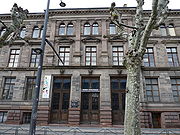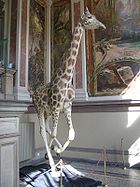
Musée zoologique de l'ULP et de la ville de Strasbourg
Encyclopedia


Zoology
Zoology |zoölogy]]), is the branch of biology that relates to the animal kingdom, including the structure, embryology, evolution, classification, habits, and distribution of all animals, both living and extinct...
collections of the city of Strasbourg
Strasbourg
Strasbourg is the capital and principal city of the Alsace region in eastern France and is the official seat of the European Parliament. Located close to the border with Germany, it is the capital of the Bas-Rhin département. The city and the region of Alsace are historically German-speaking,...
, managed and curated by the University of Strasbourg
University of Strasbourg
The University of Strasbourg in Strasbourg, Alsace, France, is the largest university in France, with about 43,000 students and over 4,000 researchers....
.
History
In 1804, the city of Strasbourg purchased all of the natural history collections of Johann HermannJohann Hermann
Johann, or Jean, Hermann was a French physician and naturalist. He was professor of medicine at the University of Strasbourg. He was the author of Tabula affinitatum animalium and Observationes zoologicae quibus novae complures, published posthumously in 1804...
. When the University of Strasbourg
University of Strasbourg
The University of Strasbourg in Strasbourg, Alsace, France, is the largest university in France, with about 43,000 students and over 4,000 researchers....
was created anew in 1872, the management and curation of the museum was entrusted to it. A spacious new building was erected from 1890 to 1893 and the collection continued to grow.
The museum has collections of birds, marine mammals, invertebrates and insects, with a very particular focus on Alsatian
Alsace
Alsace is the fifth-smallest of the 27 regions of France in land area , and the smallest in metropolitan France. It is also the seventh-most densely populated region in France and third most densely populated region in metropolitan France, with ca. 220 inhabitants per km²...
fauna. There is also a reconstruction of the cabinet of natural history of Johann Hermann with many documents and specimens of his time.
Collections
The collections include:- 1,350,000 invertebrates
- 1,000,000 insects
- 18,000 birds
- 10,000 mammals
- 2,450 fishes
- 1,300 reptiles and amphibies

